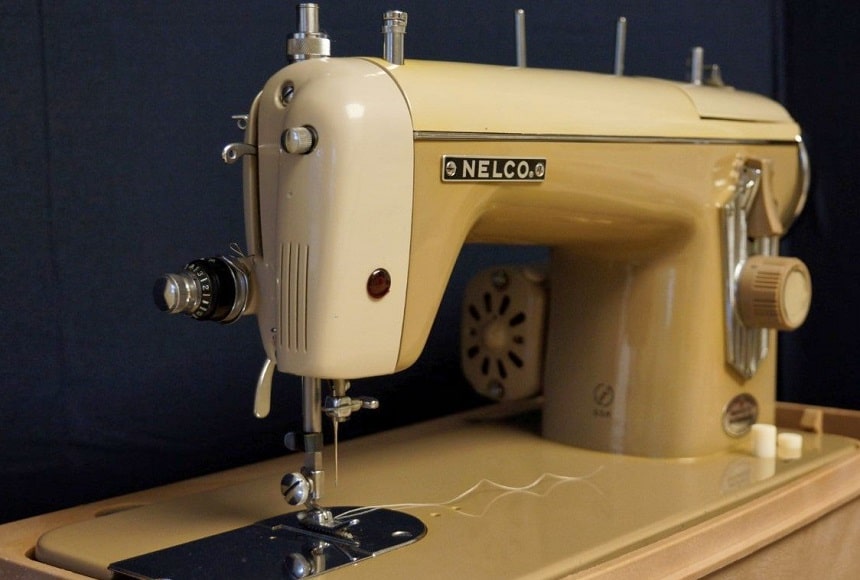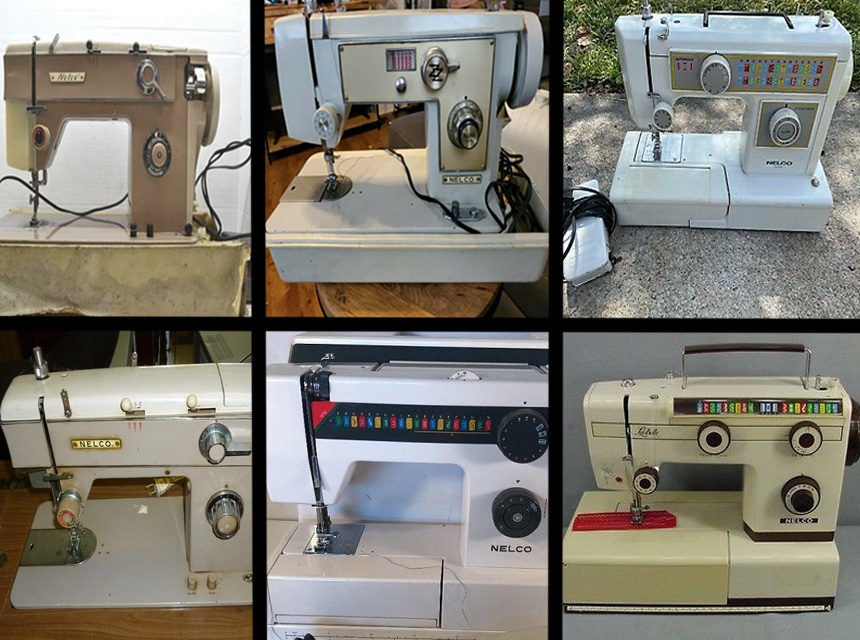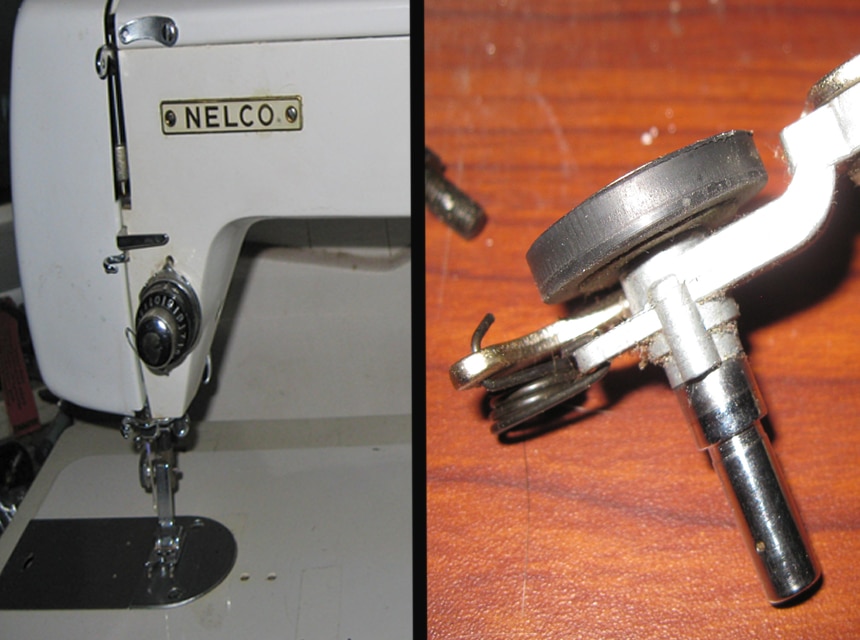

Many Nelco sewing machines are still up and running after 40 or 50 years of continued service. This is all thanks to their rugged metallic build. The Nelco Sewing Machine Company was founded by a renowned man; Leon Jolson, who made a name for himself in the sewing machine industry at a very young age. There is a long interesting history behind the creation of Nelco machines. Most users think buying a Nelco machine is a great way of spending less to preserve a piece of history. And we’re going to tell you all about Nelco sewing machines in this article!
So are Nelco any good? Well, we can’t really speak for all models. You might get a lemon or you might not. Although most of the models are durably built with metal parts. There are sewists that swear by the machines and claim that they have used theirs for more than 20 years. Others still have theirs going strong after 45 years. Read on for more details on the history of Nelco sewing machines, the different models, and how you can easily thread one.
(If you’re a history buff , check out our other articles like everything you need to know about Montgomery Ward sewing machines)

The Nelco sewing machine was created by Leon Jolson who was born in Warsaw Poland. By his 25th birthday, he had already joined his father in the sewing machine industry and achieved significant success. He was leading in the Eastern Europe sale for the Necchi Corporation Trusted Source Necchi sewing machine Necchi sewing machine was founded in 1919. The Necchi brand, is known among professional and home-use sewists for its premium design and reliability. The brand continues to have the innovative design, sturdy construction, and excellent stitch quality that made it a favorite in the past, and is gearing up for a major resurgence. – Necchi sewing machine www.mynecchi.com .
Besides being a sales manager at Necchi, he also contributed to the creation of Necchi’s all-purpose sewing machine that could perform more than 20 tasks normally done by hand.
Leon’s life was interrupted when Poland got invaded by Nazi Germany. He was sent to a concentration camp in 1943 but his mechanical and sewing skills that were valuable to the Nazis afforded him freedom of movement, and he was soon reunited with his family.
When the war ended in 1945, Jolson and his wife found themselves in the US. In 1947, he was in New York penniless but he immersed himself in the garment industry trying to find out how sewing machines were bought and sold. At that time, the machine trade was bustling because sewing machine parts were scarce.
Business owners wanted to focus on making garments while buyers needed agents who could do the footwork purchasing parts and machines for them.
He made a decent earning from being an agent. After a while, he got a loan and put up his first workshop in a Bronx apartment. Jolson first step to success was discovering that the American sewing machines lacked some of the crucial features of the Italian Necchi models he had helped build some time back.
He wrote to Necchi explaining that America was a promising market but they showed no enthusiasm for his idea. They kept telling him that he needed to prove the demand with a sizable order. They would take long to respond and would only send him a few demonstration machines.
The company’s reluctance did not make him lose hope. He went ahead to get a second loan which he used to pursue American distributors. This turned out to be another huge set back but he did not give up.
Eventually, he got 2 investors who invested 50,000 dollars that got America the first 135 Necchi machines. Within 2 weeks, they manage to sell 10000 machines and they got great support from Necchi. The business grew rapidly and they even became the US dealer for Elna Trusted Source Elna - Welcome Welcome to your special sewing universe. Explore it with elna and follow-us into our inspirational planet. www.elna.com -the Swiss brand which was another forward-thinking design with lots of exciting features.
With time, 1 in 4 machines bought in America, was imported by Jolson’s company. His marketing budget was a whopping 2.5million dollars and his annual revenue 25million dollars a year in 1952.
By this time, Japan had increasingly become an influencer in the market with their superior quality budget machines. Jolson realized that he needed a lower-cost option that would compete with the cheap Japanese machines.
He contracted with a Japanese manufacturer to create Nelco. The Nelco machines grew in popularity and were sold in famous department stores like Walmart.
As much as he relied on Japanese engineering for his machines, he purposed to maintain the European aesthetic. The machines had some style features similar to that of Necchi machines. They were the ultimate budget alternative to the high-end Necchi machines. Nelco captured 25% of the American market which sounds like a tiny fraction but it was a big deal considering the dominance Singer machines had on the market.
Just to be clear, Nelco machines weren’t anywhere near Necchi in terms of capabilities and aesthetic sophistication but the unique Japanese engineering made them rock solid and versatile with a fantastic straight stitch and a few basic zig-zag options.
When Jolson and his partners became a household name, Elna and Necchi could not help but notice more than just his ability to capitalize on the well-built low-budget Japanese machines. Both companies sued Jolson for appropriating their brand names. The claimed ‘Nelco’ was created from ‘NEcchi and ELna Company.’ He had also acquired the trademark Necchi-Elna sewing circle for his dealers.
In 1963, Jolson’s dealerships and licensing with Necchi and Elna were ended by lawsuits but he was allowed to keep the name Nelco after a few negotiations. Later, he was barred from using the brand names Elna and Necchi in his corporate literature.
On top of being great sewing machines, Nelco machines have a great history that make them a meaningful possession. Owning a vintage Nelco machine will remind you of a holocaust survivor and America’s greatness as the boiling pot for endless opportunities. It also gives the backstory of the garment industry in post-war America and how intriguing corporate was in the sewing industry.

Mr. Jolson’s company produced quite a number of models over the years of its operation. Some of the popular models include; the Nelco ultra sewing machine 5102a, 5102f, the Labelle Xonic 235, the Lyra R-1000, the SZ-217, the Nelco ja38 and the YM-7.
Other popular models were the Nelco Sierra 234f, R-400 and R-2000, and the Nelco Prima Vera which was a typical copy of the Elna Primula model and the Necchi Supernova Julia.
All the models were sold in mainstream stores like Walmart and JC penny. The stores gave Jolson access to both the middle class and the lower class.
Here is how to thread any Nelco sewing machine, whether it is a Nelco labelle, Nelco ultra or Nelco deluxe sewing machine. For you to understand these steps you must familiarize yourself with the parts of a sewing machine, especially if you are a novice sewist.

Slide the throat plate towards the left. Urn the handwheel toward the needle to move it to the highest point. Use your left hand to lift the bobbin case then remove it from the machine. The bobbin will drop out when you hold the open end of the bobbin case downward.
With your left hand, hold the handwheel then disconnect it from the machine by turning the stop-motion screw with your right hand. Next, place a spool of thread on the spool-pin then pass it through thread guides. Wind about 7 or 8 turns on an empty bobbin before placing the bobbin on the bobbin-winder shaft. Run the sewing machine until the bobbin stops to wind the thread on its own. Remove the fully winded bobbin from the machine then tighten the stop-motion screw.
Hold the bobbin case and the bobbin, then simply insert the bobbin into the bobbin case. Draw thread under the tension spring located between the fork-shaped openings.
Turn the handwheel toward you to move the needle to its highest point. Slide the throat plate towards the left then take the bobbin case by the latch with your left hand’s thumb and fore-finger. Fit the bobbin case to the shuttle. Ensure the bobbin-case hole is at the center of the poet of the shuttle. Release the latch and press bobbin case into the shuttle until it clicks in perfectly. Allow at least 4 inches of thread to hang freely from the bobbin.
Turn the handwheel toward you to raise the thread take-up lever to the highest point. Lead thread through threading points like indicated in numerical order on the machine. Thread the needle from left to right.
The upper thread should remain slack, therefore, hold it loosely. Turn the handwheel toward you to lower the needle and bring it up again with the lower thread. To pull up the lower thread, draw the upper thread with your hand. It will be pulled up through the stitch hole of the needle plate. Finally, place both the upper and lower threads under the pressure foot.
In case you have no idea what brand of thread to buy or you are overwhelmed by all the options out there, check out the popular MILIJIA 50Pcs Prewound Bobbins/Sewing Threads Kits. The kit has 50 pieces in 25 different colors. You can trust the threads to not fray or break easily owing to the high-quality polyester make-up.
As for sewing machine needles, the YICBOR 6packs Organ Flat Shank remains one of the most acclaimed needle set by users and experts. The set features 6 packs of organ needles in 7 different sizes. Each pack contains 10 pieces of needles. According to most reviews, they must be the best domestic needles on the market. They are best suited for household machines like the Nelco sierra 234f sewing machine.
Currently, the market is filled with different types of sewing machines from various brands, both old and new, that choosing one for your domestic or commercial use can be a challenge. A Nelco sewing machine is one of the best sewing machines you can invest in. It gives you a big bang for your bucks and it also gives you the satisfaction of owning a vintage machine with a great history behind it.
Most of the Nelco sewing machine models were copies of the Necchi and Elna models. In case you don’t know how to use a sewing machine or troubleshoot and repair one, you can always look up how to fix the Necchi and Elna machines whenever your Nelco stops working.